
With two mobile games taking two very different monetization approaches, it seems Nintendo is trying to calibrate its offerings to find out what works best for mobile apps. The runaway success of both games, however, means that it will be a while before Nintendo has clear answers.
For years, after smartphones became a real gaming platform, major game studios always kept their distance. That’s changed now, as everyone from EA to Ubisoft and 2K has their mobile offerings, from ports to entirely new games designed for smartphones, but despite this, Nintendo has continued to hold on for a long time. That all changed last year, first with the launch of Pokemon Go. The game was a phenomenal success and for a while you saw people from all walks of life buried in their phones looking for Pikachu, before even the launch of the game in India.
Pokemon Go was not a Nintendo game, although it was very closely associated with the Japanese gaming company. However, a few months later this was followed by Super Mario Run. The game has its fair share of problems, including an always-online requirement that irked many, but it was particularly interesting for the price point that Nintendo chose to follow. Although Super Mario Run is free to download and play, you can only access a very small part of the game. The app is more like a free demo, and to unlock the full game you need to pay $9.99 ( now Rs. 800 in India). Leaving aside the fact that this is a pretty steep price for what was, without Mario’s trappings, a fairly ordinary auto-runner, the price also seemed to give a hint as to how Nintendo planned to monetize its mobile games.
![]()
It’s not that different from the shareware era of PC gaming (if you remember correctly), where you got free demos that passed around and gave you a good chunk of the game; in theory, if you liked it, you could pay the developers and they would send you the rest of the game. In practice, most people would find pirated versions, but that’s another story for another day.
The point is that Nintendo identified what it thought was a reasonable price for its software and asked for it up front, something that also happens with Nintendo games on its own platform. You buy the game, then you play the game.
With Fire Emblem Heroes, released in select regions earlier this month, the company has taken a diametrically opposed stance. The game is free to download and the full game is available immediately. You still won’t be able to access all of this right away, but it’s not because of a financial barrier; instead, it’s locked behind difficulty levels.
Fire Emblem heroes take on the Free to Play mechanics that so many people don’t like in mobile games and have multiple currencies that are used in different ways. You’ll find yourself out of orbs, stamina, feathers, you’ll end up with a hero you really want who’s out of stars, so you’ll be forced to use an inferior hero just because he’s at a higher level. The game continues to dangle the promise of improvements through perseverance, as it offers rewards via a random drop that rarely gives you everything you really want.
![]()
Fire Emblem Heroes Tips and Tricks for Beginners
Until you decide to spend some money. After all, it’s a great game and you can see yourself enjoying it for hours; days or weeks could even pass. Surely the developers deserve something for all their work? And then you see someone else whose hero roster is much better than yours, and you think it probably won’t hurt to spend a little more, and then a little more. Or maybe you stop after the first expense. Either way, as long as you’re comfortable with the idea of spending money, there’s nothing wrong with that either.
But the question you have to ask yourself is: why is Nintendo taking such opposite approaches to making money from mobile apps? Leaving aside the specifics of the two games for a minute and focusing solely on monetization, the conclusion could be that Nintendo wants to determine which mode would be more profitable: making every user pay for the game, or having a few users subsidize. the rest.
In the F2P model that Nintendo follows, a few “whales” (high-paying customers) will generally subsidize all the free players, and that’s a well-established model at this point. On Reddit, one user shared a photo showing a maxed-out barracks and wrote that it involved a $1,000 expense. In other words, this user brought in as much money as 100 people buying Super Mario Run. If both games had 100 users and 99 people didn’t pay Nintendo a cent for Fire Emblem Heroes, they would still be level.
![]()
This seems to work. According to a report by VG247, Fire Emblem Heroes grossed over $5 million (around Rs. 33 crore) in its first week. But App Annie reported that Super Mario Run grossed $14 million (around Rs. 93.5 lakh) in its first three days.
The fact is that both games were huge successes. They have a huge built-in audience for their respective brands, and the Nintendo brand is nothing to scoff at either. Result: fairly ordinary mobile games, which do not deviate from established conventions, print money.
The problem is that they also don’t provide specific information on monetization modes and what will work best in the long run. For these reasons, we expect Nintendo to continue releasing mobile games in the near future and continue experimenting with different monetization strategies until it can actually generate useful data on what gamers expect from the company. Hopefully it will also attempt to introduce more innovative games, and not just repeat basic mobile games, in future iterations, otherwise the hype around the Nintendo brand on mobile will certainly die down over time.
Tech




